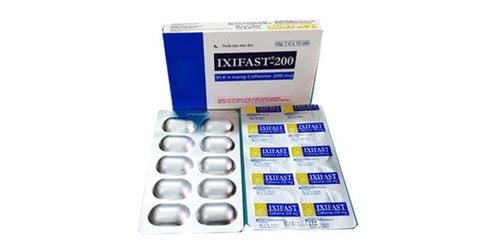This is an automatically translated article.
Kaprocin is an antibiotic used in the treatment of infections of the respiratory, kidney or urinary tract and genitals. Kaprocin is taken orally and the following article will describe more about its uses, usage, and notes when using the drug.1. What is Kaprocin?
Kaprocin is an antibiotic that is prepared in the form of long film-coated tablets. With the main active ingredient being Ciprofloxacin, Kaprocin is classified as a semi-synthetic antibiotic with a broad spectrum of antibacterial activity, belonging to the Quinolone group. This class of antibiotics is also known as DNA girase inhibitors.
Ciprofloxacin content in each Kaprocin compress is flexibly prepared according to the manufacturer, including 100mg, 150mg, 200mg tablets up to the high content of 750mg.
2. What disease does Kaprocin treat?
Kaprocin's main use is based on the active ingredient Ciprofloxacin contained in the drug. As mentioned above, this drug is an active ingredient that inhibits the bacterial DNA Girase enzyme, thereby blocking Chromossomal replication causing the bacteria to slow down the reproduction and replication process, thereby inhibiting the number of bacteria. bacteria causing infection. Kaprocin has a good effect on bacteria resistant to antibiotics of other groups (Aminoglycosides, Cephalosporins, Tetracylins, Penincilins). In the group of fluoroquinolone antibiotics, Kaprocin is considered to have the strongest effect and diverse antibacterial spectrum, effective against many sensitive bacteria that are resistant to other antibiotics.Kaprocin's antibacterial spectrum includes:
Intestinal pathogens: Salmonella, Yersina and Vibrio cholerae, Shigella; Bacteria that cause respiratory diseases: Haemophilus, Mycoplasma, Chlamydia; Gram-positive bacteria of strains Streptococcus, Listeria monocytogenes, Enterococcus, Staphylococcus are less susceptible. Pharmacokinetics of Kaprocin:
Kaprocin is well absorbed from the gastrointestinal tract. According to clinical studies, in the presence of food and anti-acid drugs, the absorption of Kaprocin is slow but bioavailability does not change too much. After taking a dose of 250mg in a 70kg patient, the patient's maximum serum concentration was 1.2mg/liter, with higher doses when taking, the drug concentration in the serum is also proportional.
Regarding the elimination of Kaprocin, the plasma half-life of the drug lasts from 3.5 to 4.5 hours in patients with normal kidney function, the plasma half-life of the drug will be longer in patients with renal failure. kidney or elderly. Kaprocin is eliminated mainly in the urine through glomerular filtration and tubular secretion.
Kaprocin is evenly distributed in tissues in the body and is slightly higher in areas of infection and infection. With an intravenous dose, up to 75% of the drug is excreted unchanged in the urine, 15% in the faeces.
3. Indications for taking Kaprocin
Kaprocin antibiotics are used in the following cases:
Patients with severe infections, for which conventional antibiotics are ineffective or resistant, typically in the upper urinary tract infections and lower back, prostatitis, osteomyelitis, severe enteritis, hospital-acquired infections. Prophylactic treatment in meningococcal and bacterial infections in immunocompromised individuals.
4. Contraindications to taking Kaprocin
Contraindicated to use Kaprocin in patients with hypersensitivity to Ciprofloxacin or Quinolone antibiotics. Kaprocin is contraindicated in pregnant and lactating women, infants and young children. Kaprocin is contraindicated in epileptic patients, in patients with a history of tendon rupture and tendinitis.
5. Dosage and how to use Kaprocin
Kaprocin is used orally in the dosage form of film-coated tablets. Depending on the dose and the user, it is reasonable to choose, for example, if the dose is 200mg/time, you should choose Kaprocin with a content of 200mg Ciprofloxacin/tablet.
Dosage of Kaprocin in adults
Mild infections: Use 250-500mg/time, 2 times a day. In case of severe infection including complications: 750mg/time, 2 times a day. Dosage maintenance 5-10 days. Dosage of Kaprocin in patients with renal failure
Creatinine clearance 30-50ml/min: Dose 250-500mg/time, take 1 dose every 12 hours. Creatinine clearance 5-29ml/min: Dose 250-500mg/time, take 1 dose every 18 hours. Patients in the process of dialysis: Dose 250-500mg / time, take 1 dose every 24 hours.
6. Side effects of the drug Kaprocin
Kaprocin is an antibiotic used in the treatment of severe infections, besides antibacterial effects, Kaprocin also brings common and rare side effects as follows:
Common side effects: Patients feel anorexia, gastrointestinal disturbances, heartburn, nausea, abdominal distention, headache, increased BUN, elevated liver enzymes Rare side effects (severe): Oral mucositis, shock, photosensitivity, edema, erythema, acute renal failure, pseudomembranous colitis, arthralgia, myositis, psychotic reactions. Extremely rare effects: punctate haemorrhage, purpura, small nodular haemorrhage with firm covering with vascular involvement, interstitial nephritis, Stevens John syndrome, Lyell's syndrome. Whether experiencing mild or severe side effects, patients should also notify a specialist to consider stopping the drug or treating symptoms.
7. Notes when using the drug Kaprocin
Kaprocin belongs to the group of Quinolone antibiotics, so there is no cross-effect with other antibiotics such as Aminoglycosides, Cephalosporins, Tetracyclines, Penicillins... Pay attention when using Kaprocin in patients with severe renal failure, hemodynamic disturbances, Elderly. According to the manufacturer's and doctor's recommendations, you should stop taking the drug when you feel a lot of pain, inflammation / tendon rupture. The basic information about the drug Kaprocin in the above article is for reference only. Because Kaprocin is a prescription drug, patients should not use it on their own, but need to contact a specialist directly for a suitable prescription to ensure safety for health.













